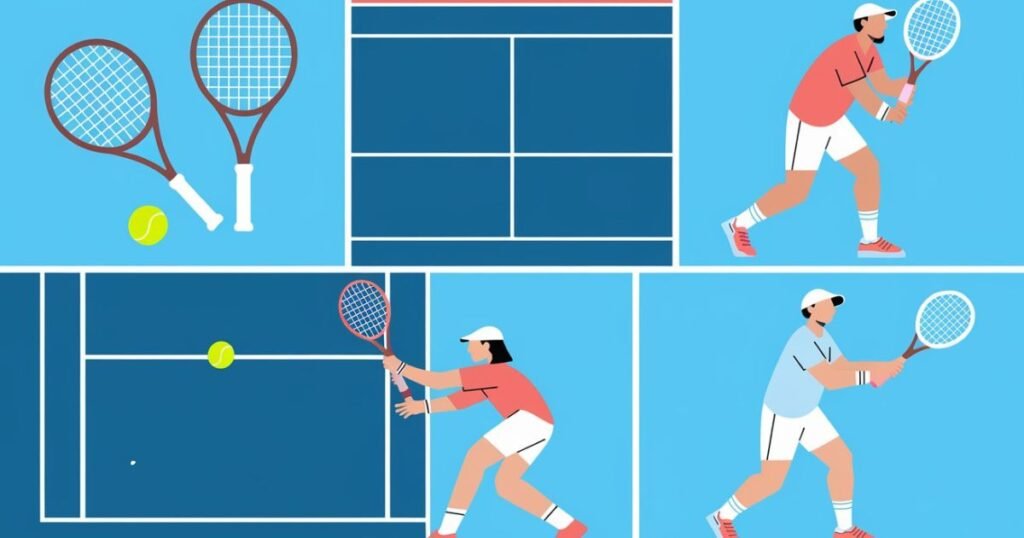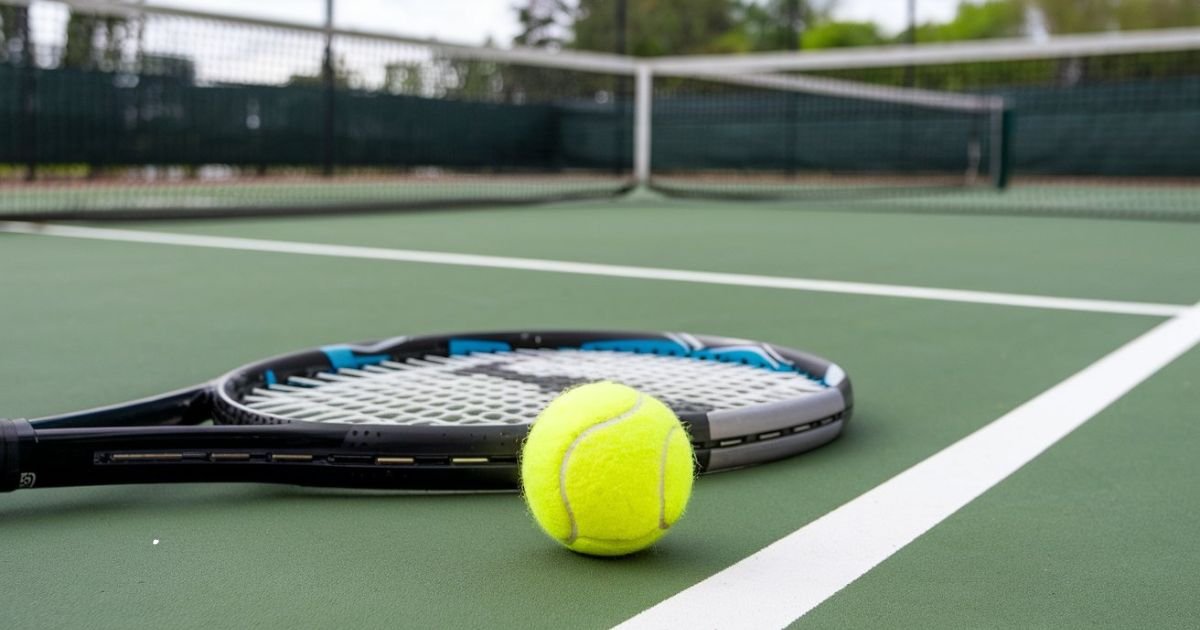Tennis is one of the world’s most popular and accessible sports. It is an excellent choice for a sport because it provides both physical and mental benefits. It’s a game that tests your agility, coordination, and strategic thinking while also providing a full-body exercise.
Whether you’re looking to learn how to play tennis for fun, fitness, or competitive reasons, the sport is suitable for people of all ages and skill levels. Tennis improves cardiovascular health, hand-eye coordination, and mental focus. Furthermore, it’s a social activity that can be enjoyed with friends, family, or even in a competitive environment.
In this guide, we’ll walk you through everything you need to know to learn how to play tennis in simple, actionable steps. By the end, you’ll feel comfortable stepping onto the court and enjoying the game. Let’s get started!
Table of Contents
Understanding the Basics of Tennis

Tennis is an exciting sport that blends physical skill with strategy. Played with a racket and a ball, it can be enjoyed in singles (one-on-one) or doubles (two teams of two). The goal is to hit the ball over a net into the opponent’s side of the court so they can’t return it. Points are scored when the opponent fails to hit the ball within the court’s boundaries, creating a dynamic game that mixes power, precision, and tactics.
Tennis has a rich history that dates back over a century, with its origins rooted in ancient ball games. The modern version of tennis evolved from these early forms into the sophisticated sport we know today. Over the years, tennis has grown into a global phenomenon, with major tournaments such as Wimbledon, the US Open, and the Australian Open becoming prestigious events that attract millions of viewers around the world.
Tennis is renowned for its strategic depth and physical demands. Each match combines athleticism, strategy, and skill, whether you’re watching professional players or enjoying a casual game with friends. Its rich history and ongoing excitement make tennis a sport with lasting appeal and intrigue.
The Tennis Court
Before stepping onto the court, it’s important to understand the layout and equipment you’ll need. The tennis court is divided into several key areas:
- Baseline: The line at the back of the court, where players stand to hit groundstrokes. It defines the depth of the court.
- Service Boxes: The area on either side of the net where the server must place the ball to start a point. It’s bounded by the service line and the net.
- Net: The barrier dividing the two sides of the court. The ball must pass over this net to be in play.
- Sidelines: The lines marking the width of the court. They define the outer edges for singles and doubles play.
Understanding these areas helps players position themselves correctly and play effectively within the court’s constraints.
Tennis Equipment
Here’s a closer look at the equipment needed to start playing tennis:
- Rackets: A tennis racket is your primary tool for hitting the ball. Beginners should choose a racket with a larger head size and a more forgiving string pattern, such as the Wilson Federer or the Head Ti S6. These features help with making better contact with the ball and provide more power.
- Balls: Tennis balls come in various types. For beginners, using low-compression balls (red, orange, or green dots) is beneficial. These balls are slower and bounce lower, making them easier to hit and control.
- Footwear and Clothing: Tennis shoes are crucial for proper foot support and avoiding injuries. Choose shoes designed for tennis, as they provide the right grip and stability for lateral movements. Wear breathable, comfortable athletic clothing that allows for easy movement.
Learn the Rules of Tennis
Scoring System
Tennis has a unique scoring system that might seem tricky at first, but it’s easy to get the hang of.
- Points: Each point starts at 0 or “love.” From there, the points progress as 15, 30, 40, and then “game”, a player must win four points with at least a two-point lead. If both players reach 40, it’s called a “deuce”. The next point won gives a player an advantage, and winning the following point wins the game.
- Games and Sets: A set consists of games, with the first player to win six games (by a margin of two games) winning the set. If the score reaches 6-6, a tiebreaker game is played to determine the winner of the set.
- Matches: Most recreational matches are the best of three sets. In professional tournaments, matches may be played as best of five sets for men and best of three for women.
Serving and Receiving
- Serving: The server starts each point. The server must stand behind the baseline and hit the ball over the net into the diagonal service box. A good serve requires practice to develop accuracy and power.
- Receiving: As a receiver, positioning is crucial. Stand a few feet behind the baseline and adjust your position based on the server’s tendencies. Being ready to move quickly helps in returning the serve effectively.
Faults, Let, and Tiebreakers
- Faults: If a serve lands outside the service box, it is a fault. The server gets two chances to serve correctly; failing both results in losing the point.
- Let: If a serve hits the net but still lands in the service box, it’s called a let, and the serve is replayed.
- Tiebreakers: In a set tied at 6-6, a tiebreaker is played. Players alternate serving and the first to 7 points (with at least a 2-point lead) wins the tiebreaker and the set.
Step-by-Step Tennis Techniques
Mastering the basics of technique is key to improving your tennis game. Below are some core skills you’ll want to focus on:
The Tennis Stance
Your tennis stance forms the foundation of every shot you hit. Stand with your feet shoulder-width apart, knees slightly bent, and your weight balanced on the balls of your feet. This “ready position” helps you move quickly and react to your opponent’s shots.
- Athletic Stance: Start with feet shoulder-width apart and knees slightly bent. This stance allows for quick lateral movements and stability. Your weight should be balanced on the balls of your feet, ready to move in any direction.
- Relaxed Arms: Keep your arms loose to facilitate fluid strokes. Tension in your arms can hinder your swing and control.
Grips
The way you hold your racket—your grip—affects the power and control of your shots.
- Eastern Forehand Grip: Perfect for beginners, this grip is easy to learn and works well for forehand strokes. Simply place the base knuckle of your index finger on the third bevel of the racket handle. This grip is versatile for hitting both topspin and flat shots.
- Western Forehand Grip: This grip generates a heavy topspin, making it great for advanced players.
- Continental Grip: Commonly used for serves, volleys, and slices. Learning how to switch between grips smoothly is key to developing versatility in your game.
Practicing different grips helps you adapt to various shots and playing situations.
Mastering Basic Strokes
- Forehand: The forehand is one of the first shots you’ll learn. For a forehand stroke, rotate your body and hips as you swing the racket. Aim to make contact with the ball in front of your body, using a smooth, controlled motion. Follow through with your swing to ensure accuracy and power.
- Backhand: You can use either one or two hands on the racket for a backhand stroke. Rotate your torso and keep your eye on the ball. Practice both one-handed and two-handed backhands to find what works best for you. The key is to stay balanced and swing with a smooth, controlled motion.
- Serve: Start with your feet behind the baseline and toss the ball slightly in front of you. Swing your racket in a fluid motion, aiming to hit the ball at its peak height. A good serve combines power and precision. Over time, you’ll develop a faster, more accurate serve.
- Volleys: Volleys are hit close to the net, and they require quick reflexes. When close to the net, use short, sharp movements to intercept the ball. Keep your racket in front of you and use quick reflexes to direct the ball back into the opponent’s court.
- Overhead Smash: This shot is used to return high balls. Position yourself under the ball, then swing down with force. Like a serve, it relies on a strong wrist snap and good body positioning.
Practice Drills for Beginners
Practicing these skills is what will take you from a beginner to a competent player. Here are some easy drills:
Solo Drills
- Wall Practice: A wall can be your best training partner. Practicing your groundstrokes against a wall improves timing and consistency. Aim for a target or line on the wall to simulate an opponent’s return.
- Footwork Drills: Work on your lateral movement by shuffling side to side and performing split steps to stay quick and agile on the court.
- Shadow Swings: Practice your swings without a ball. Focus on your form, ensuring that you use the correct grip and stance for each stroke.
- Ball Toss Practice for Serves: Stand in front of a wall and toss the ball to the same spot repeatedly. This helps you develop a consistent toss for your serves.
Partner Drills
- Rallying: Grab a partner and focus on keeping the ball in play. This will help you develop consistency and accuracy.
- Crosscourt Rallies: Rally with a partner, aiming to keep the ball within the service boxes. This drill improves your control and accuracy.
- Approach and Volley: Practice hitting an approach shot and then moving to the net to execute a volley. This drill helps you improve net play and transition skills.
- Serve and Return Practice: Take turns serving and returning to develop both your offensive and defensive game.
Ball Machine Drills
- Topspin and Slice Training: Use a ball machine to practice handling different spins. Topspin shots bounce higher, while slices stay lower. Learning to handle these will improve your overall game.
Strategies for Beginners
Once you’ve got the basics down, it’s time to think strategically. Here are some tips:
Positioning and Court Awareness
- Defensive Positioning: When on the defensive, position yourself farther behind the baseline to give yourself more time to react to the opponent’s shots.
- Offensive Positioning: When in control, move closer to the net to take advantage of short balls or weak returns. This puts pressure on your opponent and can help you finish points quickly.
Developing a Game Plan
- Identify Weaknesses: Observe your opponent’s game to identify weaknesses. For example, if they struggle with high balls, use this to your advantage by hitting deep, high shots.
- Exploit Patterns: Look for patterns in your opponent’s play. If they frequently hit to one side, adjust your positioning to capitalize on their tendencies.
Mental Toughness and Focus
- Stay Positive: Focus on your game and the positive aspects of your performance. Avoid dwelling on mistakes and instead concentrate on the next point.
- Handle Pressure: Develop mental routines to manage pressure, such as deep breathing or visualizing successful shots. This helps keep your mind calm during crucial moments.
Common Mistakes to Avoid
As you progress, watch out for these common mistakes:
- Over-Swinging: Beginners often try to hit the ball too hard. Instead, focus on making clean, consistent contact with the ball. Power will come with practice and proper technique.
- Poor Footwork: Good footwork is crucial for effective play. Practice moving quickly and maintaining balance to improve your overall game.
- Grip Mistakes: Using the wrong grip for different shots is a common mistake. Make sure to switch grips based on the stroke you’re hitting.
- Set Realistic Goals: Break your learning into achievable goals. For example, aim to master a specific stroke or improve your serve consistency.
- Seek Constructive Feedback: Use feedback from coaches or experienced players to focus on areas of improvement. Constructive criticism helps you grow and avoid making the same mistakes.
Resources for Learning Tennis
Finding Local Clubs and Leagues
- Local Tennis Clubs: Many clubs offer beginner classes and social play opportunities. Joining a club helps you meet other players and practice regularly.
- Tennis Leagues: Look for local leagues or social tennis groups. These provide structured play and help you experience different styles of play.
Online Communities and Resources
- Online Forums and Groups: Join forums or social media groups where you can ask questions, share experiences, and learn from other players. These communities offer valuable advice and support.
- YouTube Channels: Follow instructional channels for drills, techniques, and match analysis. Watching skilled players can provide new ideas and insights into the game.
Attending Tournaments and Matches
- Local Tournaments: Watching local matches helps you understand different playing styles and strategies. It also provides inspiration and ideas for your own game.
- Professional Matches: Watch professional tennis to see high-level play and advanced techniques. Observe how professionals handle pressure and execute strategies.
Conclusion
Learning how to play tennis is a rewarding journey that requires patience, practice, and a love for the game. By understanding the basics, practicing essential techniques, and engaging with the tennis community, you set yourself up for a rewarding experience both on and off the court.
Tennis offers endless opportunities for growth, fun, and competition. Enjoy the process, stay patient, and keep practicing to make the most of what tennis has to offer. Whether you’re playing casually or aiming for competitive play, the skills and experiences you gain will enrich your life and provide lasting enjoyment.
So pick up your racket, head to the court, and confidently begin your tennis career!





Pingback: Learn How to Hit a Topspin Serve in 5 Easy Step
Pingback: Types of Tennis Court Surfaces : A Beginner's Guide